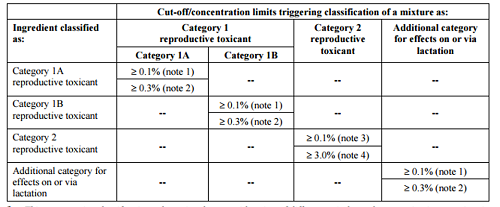Comparison of GHS Classification Concentration Limits for Reproductive Toxicity
Little Pro on 2017-01-09
Option is a good thing for differentiation but not a good thing for harmonization. UN GHS allows individual countries or authorities to choose their concentration limits for reproductive toxicity classification: 0.1%, 0.3% or 3%. This has created big challenges for companies trying to prepare one global SDS or label for all countries. In this article, we have summarized global GHS classification concentration limits for reproductive toxicity covering EU, USA, Canada, China, Japan, Korea, Taiwan, Malaysia, Thailand, Vietnam, Australia and Singapore.
What is GHS Concentration Limit
GHS concentration limit is the minimum concentration for a hazardous substance to trigger the classification of a mixture containing it. They are mainly expressed as % thresholds and are primarily used for mixture classification under GHS. If you do not know what GHS concentration limit is, please click here.
UN GHS Purple Book
The table below summarizes GHS concentration limits for reproductive toxicity classification in UN GHS purple book. There is no fixed concentration limit given for reproductive toxicity category 1, 2 or additional category for effects on or via lactation.

For the meaning of note 1, 2, 3 and 4, please refer to UN GHS purple book. Usually the labelling of a category 1 reproductive toxicant is required if its concentration is >=0.3% and the labelling of category 2 reproductive toxicant is required if its content is >=3%. However, all reproductive toxicants (>=0.1%) must be shown in SDSs depite whether the mixture containing them will be classified as reproductive toxicant or not .
Table of Concentration Limits for Reproductive Toxicity
| Jurisdiction | Category 1(1A/1B)/Effects on or via lactation | Category 2 |
|---|---|---|
| UN | >=0.1% or >=0.3% | >=0.1% or >=3% |
| USA | >=0.1% | >=0.1% |
| Canada | >=0.1% | >=0.1% |
| China | >=0.1% or >=0.3% | >=0.1% or >=3% |
| Taiwan | >=0.1% or >=0.3% | >=0.1% or >=3% |
| Vietnam | >=0.1% or >=0.3% | >=0.1% or >=3% |
| EU | >=0.3% | >=3% |
| Japan | >=0.3% | >=3% |
| Korea | >=0.3% | >=3% |
| Malaysia | >=0.3% | >=3% |
| Thailand | >=0.3% | >=3% |
| Singapore | >=0.3% | >=3% |
| Australia | >=0.3% | >=3% |
Summary
Most of APAC countries have followed EU's concentration limits for reproductive toxicity classification while USA and Canada have adopted the strictest concentration limits. China, Taiwan and Vietnam are quite unique since they let companies to choose which concentration limit to use.
References
List of free GHS regulations and resources
Advanced GHS Readings
- Global GHS Label Size Requirement
- Global GHS Label Requirement for Small Containers
- GHS and Pesticides
- GHS Classification List
- GHS and Confidential Business Info
- List of GHS Resources and Regulations
- Comparing GHS Builing Blocks in EU, USA, China and Japan
- Correlations between TDG and GHS
- When Should You Update Your SDSs
Having Questions?
We do not provide consultancy services. If you have questions or need any help, please contact our sponsor. You may also find an expert in CSP business directory below. If you are a consultant, you may get yourself listed in CSP business directory (free) or sponsor this page to leave your contact info on this page..

Tags: Topics - GHS, GHS Basics and Tutorials